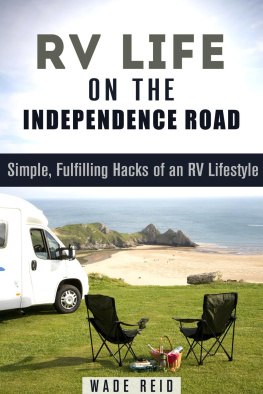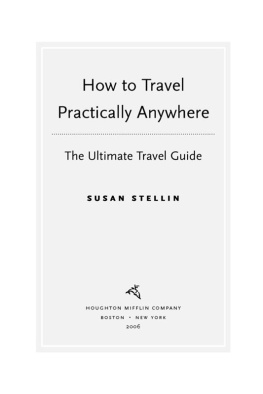RV Life on the Independence Road
Simple, Fulfilling Hacks of an RV Lifestyle
Copyright Notice
Reproduction, duplication, transmission of this document in part or in whole is permitted only with written permission from the publisher. All rights reserved.
Respective brands and trademarks mentioned in this book belong to their respective owners.
Disclaimer
This document is geared towards providing summarization of information related to the topic. While all attempts have been made to verify the accuracy of the information, the author does not assume any responsibility for errors, omissions, or interpretations of the content. The information is offered for informational or entertainment purposes only. If professional advice is necessary, a qualified legal, medical, financial or another respective professional should be consulted. The reader is responsible for his or her own actions. The publisher does not accept any responsibility or liability arising from damages or losses, real or perceived, direct or indirect, resulting from the use of this information.
Table of Contents
Introduction
T he Pioneer Spirit. A clarion call of freedom that had been at the heart of Americans since the original colonies were developed over five hundred years ago.
A growing number of people are making the transition to smaller, less opulent homes, and that trend may further expand in the next decade, as incomes shrink and work opportunities become sparser. The luxury of having your home ready to roll with you is not only exciting, it opens up worlds of possibilities.
Enter the Recreational Vehicle, also commonly known as a Motorhome. A lifestyle centered on a home that can move, can relocate, is an appealing way to go for younger families and individual, allowing the hubbub that is usually associated with job relocation no longer a great source of stress.
This book serves as an introduction to this lifestyle, and offer the kind of information you need to get started, if that is your plan for the future. From description of the various types and amenities, to checklists for making your RV experience fantastic.
In addition, though, there is a different, also growing number of people whose lifestyle is already established, and are looking for a life of leisure, a path that will set them free from the usual costs of vacationing, and will give them autonomy they havent explored before. This book too, will serve as a great set of guideposts, to make your RV experience the very best it can be.
So, whether your Recreational Vehicle will serve as your home, or your home away from home, you will find the tips valuable, the hacks essential, and the advice immensely helpful as you make your way across this great country.
See you on the road, America!
Chapter One: What Does The "RV Lifestyle" Entail?
I n this chapter, you will learn:
- The three classifications of RVs their similarities and differences, and the reasons behind each of them.
- Special tricks for the RV traveler, no matter why they chose it.
The RV as Home Base
F rom the beginning of time, the concepts of what constitutes a home have been argued, often quite vigorously. Choosing whether to put down roots and own property, or to have a home that changes location from month to month, or, yes, from day to day is sometimes difficult.
Even within the broader category of Mobile homes, considerable decision making is required, and the options, though not truly endless, do hold a broad array of choices for the prospective RV owner. Below are some basic guidelines and alternatives for embarking on your RV-owners Journey
Mobile Homes
Although technically able to be moved from place to place, this subcategory of portable home does not qualify for the general description of a motorhome or RV. They are included here, because the real virtue of this style of home is that it can be placed onto a frame, creating a more permanent utility, or left with the means to move it from temporary moorings (usually called blocks, chocks, or posts) as the owner desires. Historically much less expensive that most static home types, this entry level allows home ownership to a much larger field of Americans.
The premium of the mobile homes are ones that actually are built in adjoining pieces, creating a means to have a much larger home, in terms of width, than a single lane of a roadway would allow. Most common are double-wide mobile homes, but there are floor plans that can be created with three, or even four of the road capable substructures. They can have prices that rival stick build or other pre-constructed home types, but once affixed to a foundation, such are just as secure and structurally sound. Further, with a frame that is usually steel, there are fewer risks, such as termites, that can adversely affect them.
Like the multi-wide constructs, modular can be moved from location to location, but generally do require more contact and interconnection with the site. Most are used as office or classroom additions, before more solid structures are completed. A few of these modular designs end up as housing, but their tendency to be more of a temporary nature means they are not as equipped to handle the rigors of everyday operation.
The standard mobile home template is established on a frame that meets freeway specs for any normal trailer length and width, but usually has some leeway in actual size. These are generally 12-14 wide, and can go as long as 72 feet in length. A small family or young adults can take great advantage of this low-cost alternative to rental, and build at least a modicum of equity, particularly if the unit is in a well-established and pleasant mobile home estate or park.
Motor Coaches & Motor Homes
Under this broad spectrum of choices, the fundament that holds them together is the right to be driven on public roads. From the Goliaths of the big Diesel Pushers to the tiniest Auto-class putter, these all share the characteristics that they burn fuel and can travel on just about any street in the country.
The master class of the RV world are the Class A Motorhomes. Converted from buses or built specifically for the niche, the Class A units are the most sophisticated and powerful of the motorhome category, with power and price tag at the top of the heap. Most of the units are custom-built, and have all the amenities and value of a stick-built or pre-constructed home, at a price tag to match. Size-wise, these beasts push the boundaries, putting the driver oft times directly over the left front wheel, and putting the motor either far to the rear, or far forward. The drive wheels are always to the rear, so where the motor resides determines if the vehicle is a Pusher or a Puller
Surprisingly, the Class B category of RVs/motorhomes are the smallest, most restrictive, yet the simplest to operate. No special licensing is required, they tend to get the best gas mileage of the three categories, and because they are built on or are converted from standard cargo van-sized vehicles, they usually can be driven as any automobile, and even can have low enough clearance to be garaged or parked in any conventional auto space. In the next chapter, we will go through the various amenities found in RVs, and the Class B tends to have minimal options, and less luxurious ones than either of the other two classes.
Class C Motorhomes are the so-called middle of the road rolling homes away from home. They are usually built on a cargo truck frame, with at bed in a loft over the cab, a bed conversion in the mid-body of the floorplan, and occasionally a third bedroom area on the tail. Most Class Cs do not have special licensing, though in some states, a special certificate is required. Generally speaking, the Class C has a considerably vast set of amenities and options, and are more luxurious by far than their smaller cousins, the Class Bs.
Next page








